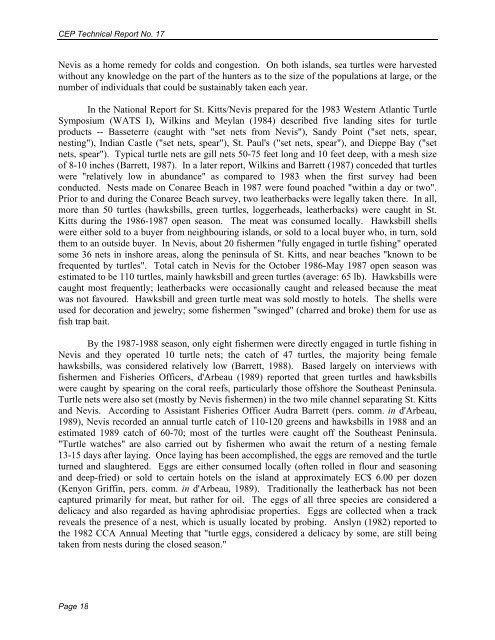Sea Turtle Recovery Action Plan for St. Kitts and Nevis - WIDECAST
Sea Turtle Recovery Action Plan for St. Kitts and Nevis - WIDECAST
Sea Turtle Recovery Action Plan for St. Kitts and Nevis - WIDECAST
Create successful ePaper yourself
Turn your PDF publications into a flip-book with our unique Google optimized e-Paper software.
CEP Technical Report No. 17<br />
<strong>Nevis</strong> as a home remedy <strong>for</strong> colds <strong>and</strong> congestion. On both isl<strong>and</strong>s, sea turtles were harvested<br />
without any knowledge on the part of the hunters as to the size of the populations at large, or the<br />
number of individuals that could be sustainably taken each year.<br />
In the National Report <strong>for</strong> <strong>St</strong>. <strong>Kitts</strong>/<strong>Nevis</strong> prepared <strong>for</strong> the 1983 Western Atlantic <strong>Turtle</strong><br />
Symposium (WATS I), Wilkins <strong>and</strong> Meylan (1984) described five l<strong>and</strong>ing sites <strong>for</strong> turtle<br />
products -- Basseterre (caught with "set nets from <strong>Nevis</strong>"), S<strong>and</strong>y Point ("set nets, spear,<br />
nesting"), Indian Castle ("set nets, spear"), <strong>St</strong>. Paul's ("set nets, spear"), <strong>and</strong> Dieppe Bay ("set<br />
nets, spear"). Typical turtle nets are gill nets 50-75 feet long <strong>and</strong> 10 feet deep, with a mesh size<br />
of 8-10 inches (Barrett, 1987). In a later report, Wilkins <strong>and</strong> Barrett (1987) conceded that turtles<br />
were "relatively low in abundance" as compared to 1983 when the first survey had been<br />
conducted. Nests made on Conaree Beach in 1987 were found poached "within a day or two".<br />
Prior to <strong>and</strong> during the Conaree Beach survey, two leatherbacks were legally taken there. In all,<br />
more than 50 turtles (hawksbills, green turtles, loggerheads, leatherbacks) were caught in <strong>St</strong>.<br />
<strong>Kitts</strong> during the 1986-1987 open season. The meat was consumed locally. Hawksbill shells<br />
were either sold to a buyer from neighbouring isl<strong>and</strong>s, or sold to a local buyer who, in turn, sold<br />
them to an outside buyer. In <strong>Nevis</strong>, about 20 fishermen "fully engaged in turtle fishing" operated<br />
some 36 nets in inshore areas, along the peninsula of <strong>St</strong>. <strong>Kitts</strong>, <strong>and</strong> near beaches "known to be<br />
frequented by turtles". Total catch in <strong>Nevis</strong> <strong>for</strong> the October 1986-May 1987 open season was<br />
estimated to be 110 turtles, mainly hawksbill <strong>and</strong> green turtles (average: 65 lb). Hawksbills were<br />
caught most frequently; leatherbacks were occasionally caught <strong>and</strong> released because the meat<br />
was not favoured. Hawksbill <strong>and</strong> green turtle meat was sold mostly to hotels. The shells were<br />
used <strong>for</strong> decoration <strong>and</strong> jewelry; some fishermen "swinged" (charred <strong>and</strong> broke) them <strong>for</strong> use as<br />
fish trap bait.<br />
By the 1987-1988 season, only eight fishermen were directly engaged in turtle fishing in<br />
<strong>Nevis</strong> <strong>and</strong> they operated 10 turtle nets; the catch of 47 turtles, the majority being female<br />
hawksbills, was considered relatively low (Barrett, 1988). Based largely on interviews with<br />
fishermen <strong>and</strong> Fisheries Officers, d'Arbeau (1989) reported that green turtles <strong>and</strong> hawksbills<br />
were caught by spearing on the coral reefs, particularly those offshore the Southeast Peninsula.<br />
<strong>Turtle</strong> nets were also set (mostly by <strong>Nevis</strong> fishermen) in the two mile channel separating <strong>St</strong>. <strong>Kitts</strong><br />
<strong>and</strong> <strong>Nevis</strong>. According to Assistant Fisheries Officer Audra Barrett (pers. comm. in d'Arbeau,<br />
1989), <strong>Nevis</strong> recorded an annual turtle catch of 110-120 greens <strong>and</strong> hawksbills in 1988 <strong>and</strong> an<br />
estimated 1989 catch of 60-70; most of the turtles were caught off the Southeast Peninsula.<br />
"<strong>Turtle</strong> watches" are also carried out by fishermen who await the return of a nesting female<br />
13-15 days after laying. Once laying has been accomplished, the eggs are removed <strong>and</strong> the turtle<br />
turned <strong>and</strong> slaughtered. Eggs are either consumed locally (often rolled in flour <strong>and</strong> seasoning<br />
<strong>and</strong> deep-fried) or sold to certain hotels on the isl<strong>and</strong> at approximately EC$ 6.00 per dozen<br />
(Kenyon Griffin, pers. comm. in d'Arbeau, 1989). Traditionally the leatherback has not been<br />
captured primarily <strong>for</strong> meat, but rather <strong>for</strong> oil. The eggs of all three species are considered a<br />
delicacy <strong>and</strong> also regarded as having aphrodisiac properties. Eggs are collected when a track<br />
reveals the presence of a nest, which is usually located by probing. Anslyn (1982) reported to<br />
the 1982 CCA Annual Meeting that "turtle eggs, considered a delicacy by some, are still being<br />
taken from nests during the closed season."<br />
Page 18
















